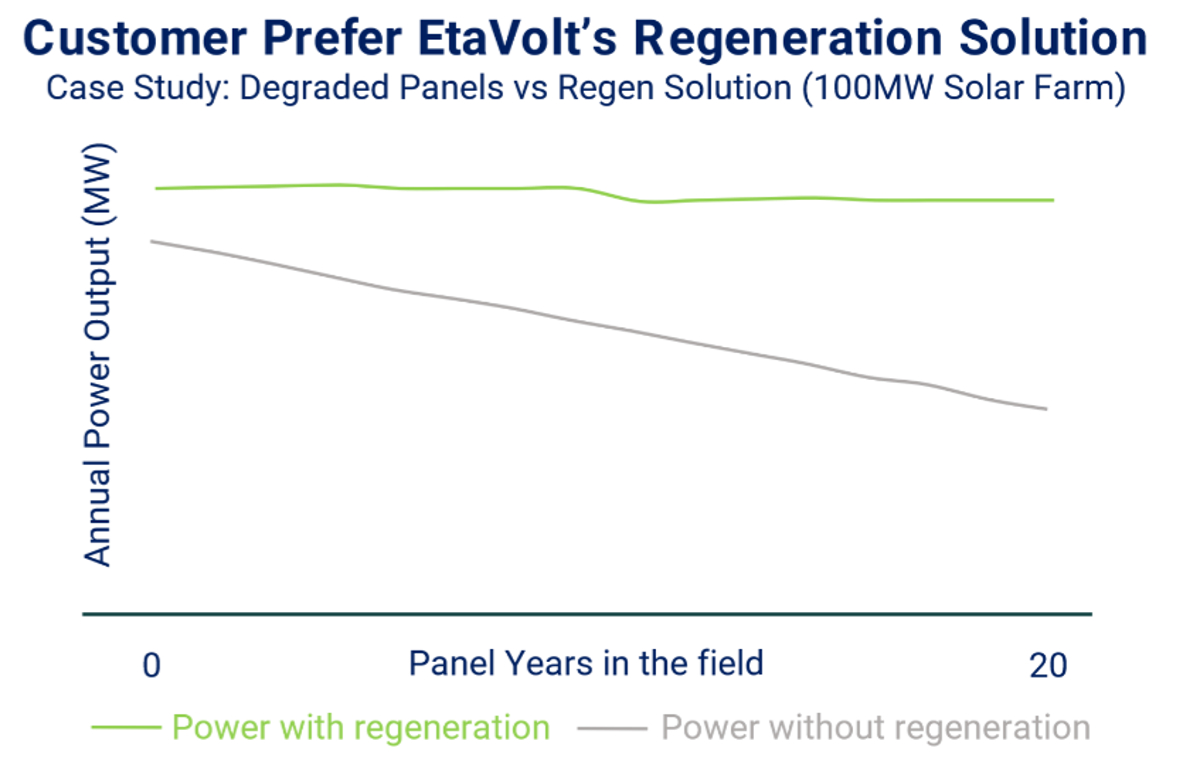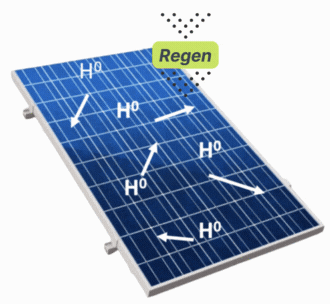Sign up for daily news updates from CleanTechnica on email. Or follow us on Google News!
Everything degrades. Our bodies, our cars, our buildings all degrade over time. Solar panels are no different. After years of making electricity from sunlight, they produce fewer electrons than when they were new. At some point, they need to be replaced — an expensive proposition whether it’s just a dozen on a rooftop or thousands in a commercial scale solar farm. The old panels are then recycled (hopefully) or simply discarded.
Researchers at Nanyang Technological University in Singapore say there is another option. After years of trials, they say they have found a way to rejuvenate existing solar panels with a process that does not require removing the panels. They have created a new company called EtaVolt to commercialize the technology.
The problem, according to EtaVolt, is light induced degradation. The very thing that makes solar panels function — sunlight — also creates “holes” in the panels that degrade their performance. Heat and humidity also contribute to the degradation process. The Advanced Regeneration Technology device created at NTU scans a standard solar panel in about five minutes. Using high intensity light, it is said to repair those “holes, bringing the solar panels back to optimum performance for up to five years. The cost of the treatment is said to be about 20 percent of the cost of a new solar installation. The procedure is applicable to 90 percent of all solar panels in use today, the company says.
“We have known for a long time that while harvesting sunlight gives us an almost inexhaustible source of energy, producing solar panels requires a lot of energy and generates a high carbon footprint. While this carbon emission can be offset by the theoretical long service life of the solar panels, estimated at 25 years, the reality is that solar panels in tropical countries face harsher conditions and there has been no real solution to restore and recycle the silicon cells — the core technology of solar panels,” Professor Madhavi, the Executive Director of NTU’s Sustainability Office, tells Interesting Engineering.
According to EtaVolt, the restoration process is like patching holes in a bucket. “It repairs solar panels to prevent energy leakage, ensuring optimal light energy collection. The process takes less than five minutes and can help treated solar panels recover up to 5% of their lost field performance. As EtaVolt explains, when precise temperature and intense light are applied to solar cells, they excite material molecules, causing them to move quickly, changing their arrangement and repairing light and heat damage.
On its website, the company features a graph that purports to show the benefit of its Advanced Regeneration Technology.

“Our solar rejuvenation method has not only been rigorously tested and validated but has shown field-proven results in various commercial applications. The technology has been successfully implemented in projects with major partners in the solar industry, such as renewable energy solutions firm Vector Green, demonstrating its effectiveness and potential for widespread adoption,” said NTU Singapore researcher Stanley Wang.
“With our regeneration solution, you could save and earn as much as you did when you first turned on your PV assets. Being an automated process, our regeneration will require less time and manpower,” the company says. “This means less time needed and costs incurred to get more out of your PV assets. We come to you. Our regeneration process is entirely onsite. This means that you can regenerate your solar panels without having to take them down and transport them someplace else. We like to leave things the way we found them, but better.”

Recycling Solar Panels
EtaVolt is not just about rejuvenating existing solar panels. At some point, all panels will degrade to the point where they are no longer serviceable. That’s when it is time to recycle them. The company says it has also developed an automated recycling facility for solar panels which it calls “a patented containerized recycling tool line and mobilized solution to achieve on-site PV recycling and reduce logistics and manpower costs.”
“With our advanced PV recycling solution, you will be able to close your PV life cycle loop. What more, our high yield recycling process recovers a greater quantity and better quality of materials. We use these gains to lower the costs for you. It is costly to transport your panels. With our turnkey recycling line in a container-sized footprint, we bring the line to you. A full featured mini-recycling plant, right at your doorstep.”
The Takeaway
All this sounds like wonderful news from EtaVolt and NTU, but we have to confess we find the company’s presentation online to be overly reliant on flowery, press release-type language backed up by too little technical information and too little real world data. We are not experts on solar panels but have not previously heard of these “holes” that can be repaired with high intensity light. Surely the company could be more forthcoming in explaining how its process works. CleanTechnica readers tend to be a skeptical lot and we imagine many of you would like more proof the Advanced Regenerative Technology actually performs its vaunted repair duties.
We have done a number of stories on recycling solar panels, none of which make it sound like an easy process. We hail EtaVolt and NTU if they have figured out how to do this in a portable, containerized process. That sounds too good to be true — which is why we would like more data and information about it.
Solar panels, by the very nature of how they are made, are deucedly difficult to take apart to recover the components inside, primarily silicon wafers that do most of the work of transforming sunlight into electricity. Two years ago, Fraunhofer ISE in Germany said it was starting to get a handle on that challenging process. It says several hundred tons of silicon will be recoverable from solar panels each year by the end of this decade.
Earlier this year we reported on SolarCycle, a California company struggling to make recycling solar panels a profitable business. Its founder, Jessie Simmons, is a former Sierra Club executive who sees the need for his company’s services increasing but is finding the process daunting. The EtaVolt solution seems a little too simple, quite honestly. If it works as advertised at reasonable cost, it could be an important new technology, but does it? “We’ll see,” said the Zen master.
Hat tip to Dan Allard.
Have a tip for CleanTechnica? Want to advertise? Want to suggest a guest for our CleanTech Talk podcast? Contact us here.
Our Latest EVObsession Video
I don’t like paywalls. You don’t like paywalls. Who likes paywalls? Here at CleanTechnica, we implemented a limited paywall for a while, but it always felt wrong — and it was always tough to decide what we should put behind there. In theory, your most exclusive and best content goes behind a paywall. But then fewer people read it!! So, we’ve decided to completely nix paywalls here at CleanTechnica. But…
Thank you!
CleanTechnica uses affiliate links. See our policy here.




